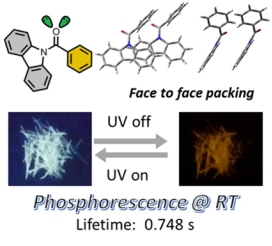Yujun Xie, Yuwei Ge, Qian Peng, Conggang Li,* Qianqian Li, and Zhen Li*, Adv. Mater. 2017, 29, 1606829.
Abstract

Long-lived phosphorescence at room temperature (RTP) from pure organic molecules is rare. Recent research reveals various crystalline organic molecules can realize RTP with lifetimes extending to the magnitude of second. There is little research on how molecular packing affecting RTP. Three compounds are designed with similar optical properties in solution, but tremendously different solid emission characteristics. By investigating the molecular packing arrangement in single crystals, it is found that the packing style of the compact face to face favors of long phosphorescence lifetime and high photoluminescence efficiency, with the lifetime up to 748 ms observed in the crystal of CPM ((9H-carbazol-9-yl)(phenyl)methanone). Theoretical calculation analysis also reveals this kind of packing style can remarkably reduce the singlet excited energy level and prompt electron communication between dimers. Surprisingly, CPM has two very similar single crystals, labeled as CPM and CPM-A, with almost identical crystal data, and the only difference is that molecules in CPM-A crystal take a little looser packing arrangement. X-ray diffraction and cross-polarization under magic spinning 13C NMR spectra double confirm that they are different crystals. Interestingly, CPM-A crystal shows negligible RTP compared to the CPM crystal, once again proving that the packing style is critical to the RTP property.
Keywords: RTP, crystal, packing style, density
Linkage: http://onlinelibrary.wiley.com/doi/10.1002/adma.201606829/full
